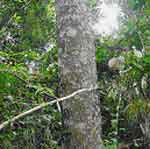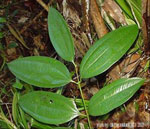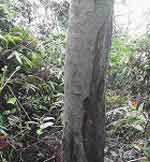|
PAST SUCCESSES
Cebu Cinnamon (Cinnamonum cebuense), The Philippines
Project Dates - June 2004 - December 2005
The Cebu cinnamon (Cinnamonum cebuense) is a little-known tree endemic to the island of Cebu in the Philippines. Cebu is one of the least forested islands in the Philippines and, in terms of endemism, one of the most important. At present, Cebu contains less than 15 km2 of open forest - less than one percent of its original forest cover.
Prior to this project, only 57 individuals of Cebu Cinnamon were known, all growing in the tiny (c. 185 ha) Tabunan Forest - the last remaining forest fragment in the Central Cebu National Park. As well as being threatened by habitat destruction, the tree is exploited locally, adding to pressure on its population.
The project was implemented by FFI’s partner on Cebu, the Cebu Biodiversity Conservation Foundation (CBCF), with funding from the Flagship Species Fund. It aimed to search for further populations of the tree to fully determine its status, examine its ecology, uses and threats and improve its protection.
Outcomes
The project located previously unknown populations of the Cebu cinnamon, improved knowledge of its ecology and local uses and greatly increased awareness and protection of the species. Specific successes were:
• The discovery of 691 individual trees not previously recorded – new populations were found in Alcoy (680 trees) and Dalaguete (11 trees). This increased the world population of the species from 57 to 748, although only 20 of these are mature trees. All 691 trees were individually marked with a tag and mapped.
• The collection of baseline information on the species, including habitat requirements, flowering and fruiting times and observations on seed dispersal. It is used locally for door and window frames (its aromatic timber is believed to bring good luck) and medicinal purposes (the bark is used to treat stomach problems).
• Increased awareness of the tree amongst local people, achieved through presentations and lectures attended by local communities and councils, billboards and posters in communities where Cebu Cinnamon occurs and nine exhibits to raise awareness of the conservation of the species. Local people now take pride in the tree and it has gained great interest from the local and regional government.
• The ongoing monitoring of Cebu Cinnamon by local people. The Alcoy and Dalaguete populations discovered during this study are being closely monitored by forest wardens and local communities. Local people are also assisting forest wardens in the search for new trees.
• The production of seedlings of Cebu Cinnamon and their replanting by local partners. These include three local organisations who have raised and replanted 1,100 seedlings and grown a further 100 wild-collected seedlings on to a size that will give them a better chance of survival when they are re-planted in the forest.
Back to Past Successes
|



|







